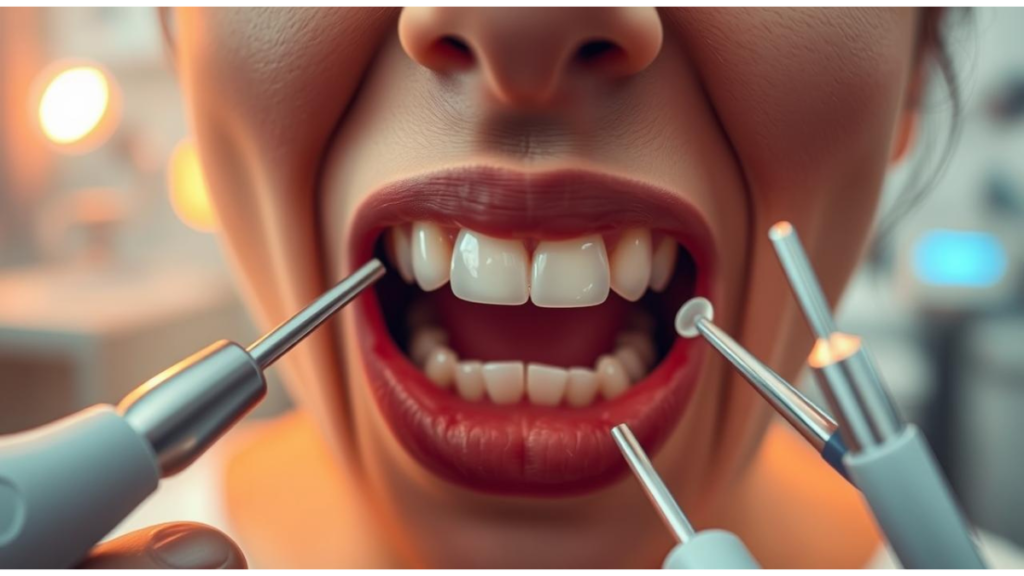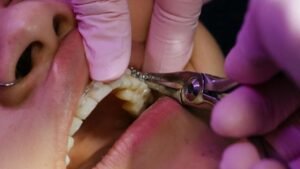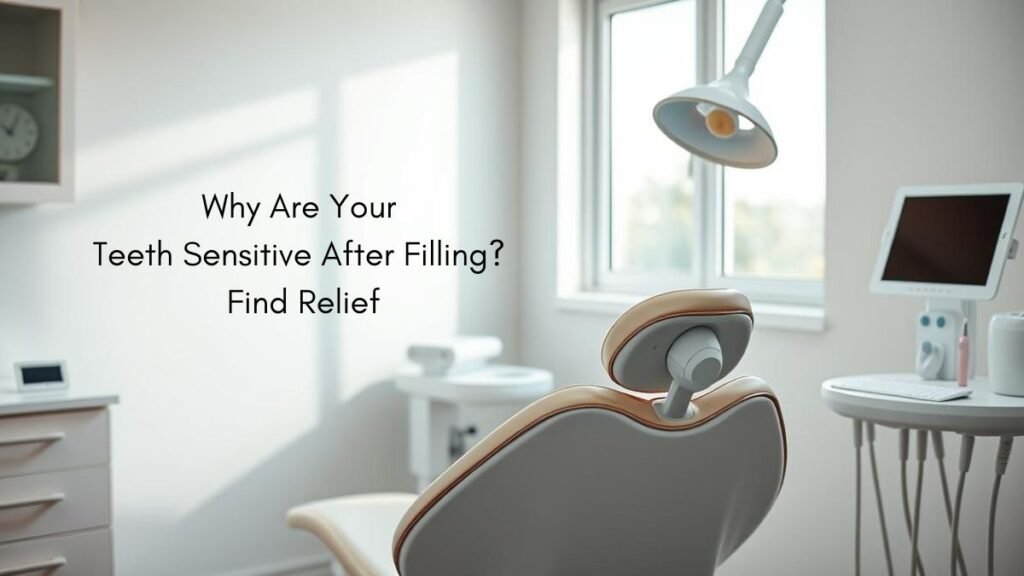Ever bitten into an ice cream cone after a tooth filling and winced in pain? You’re not alone. Teeth sensitive after a filling is common and puzzling. But why does it happen, and should you worry?
Dental procedures are necessary but can have unexpected side effects. Tooth sensitivity after a filling is one such issue. It often feels like sudden pain from hot or cold foods, sugary treats, or even biting down.
The good news is that this sensitivity usually goes away. It’s usually from the nerve inflammation during the filling. For deeper fillings, it might take days to weeks for your tooth to adjust.
But what if the sensitivity doesn’t go away? Or if it starts weeks or months later? These signs might mean you need professional help. Knowing the causes, symptoms, and treatments for post-filling sensitivity can help you manage pain and know when to seek help.
Ready to learn more and find relief for your sensitive filled tooth? Let’s dive into the world of post-filling tooth sensitivity and find a way to feel better.
Dental Fillings and Post-Procedure Sensitivity
Dental fillings fix cavities. After a filling, you might feel tooth sensitivity. This is normal and usually goes away soon. Let’s look at what happens during a filling and what comes next.
What Happens During a Filling Procedure
Your dentist removes decay and fills the tooth with materials like gold or porcelain. This can irritate the tooth’s nerves, causing sensitivity.
Normal Sensitivity Symptoms to Expect
After a filling, you might feel some discomfort. You could feel sensitivity when:
- Eating or drinking hot or cold items
- Biting down while eating
- Breathing in cold air
- Consuming sugary or acidic foods
These feelings are usually mild and get better with time. They happen because the filling can cause inflammation near the nerve.
Timeline for Post-Filling Discomfort
How long sensitivity lasts varies. Most people feel better in a few days to weeks. If it lasts more than four weeks, see your dentist.
Remember, some sensitivity is normal. But if you have persistent pain, it might be a sign of a problem. If you’re worried, talk to your dentist.
Common Causes of Teeth Sensitive After Filling
After getting a filling, you might feel tooth sensitivity. This discomfort can come from different sources. Let’s look at the main reasons for post-filling sensitivity and how they impact your dental health.
Inflammation of the Tooth Pulp
Pulpitis, or inflammation of the tooth pulp, can happen after a filling. It affects about 68% of patients, with most cases being reversible. The drilling or deep cavities can irritate the pulp, causing temporary sensitivity.
Bite Misalignment Issues
Bite alignment problems occur in 5% to 10% of dental filling cases. If your filling is too high, it can cause pressure when you bite down. This misalignment can lead to ongoing discomfort and may need adjustment by your dentist.
Allergic Reactions to Filling Materials
Allergic reactions to filling materials are rare, affecting less than 1% of patients. Symptoms may include itching or skin reactions in addition to tooth sensitivity. If you suspect an allergic reaction, talk to your dentist about alternative materials.
Referred Pain in Surrounding Teeth
About 15% of patients report referred pain after a filling. This means you might feel discomfort in teeth near the filled tooth. It’s a common occurrence that usually resolves as your mouth adjusts to the new filling.
| Cause | Prevalence | Resolution Time |
|---|---|---|
| Pulpitis | 68% | Few days to weeks |
| Bite Misalignment | 5-10% | Immediate after adjustment |
| Allergic Reaction | Less than 1% | Varies, may require material change |
| Referred Pain | 15% | 1-2 weeks |
Types of Sensitivity Triggers to Watch For
After getting a filling, your teeth might react differently to certain things. These sensitivity triggers can cause discomfort in your newly filled tooth. Knowing what triggers this sensitivity helps you manage it better.
Hot or cold food and drinks often cause a quick, sharp pain. When you sip hot coffee or bite into ice cream, you might feel a zap in your tooth. This happens because the filling material conducts temperature differently than your natural tooth.
Acidic foods can also be a problem. Things like citrus fruits, tomatoes, and vinegar might make your tooth ache. The acid can irritate the nerve endings in your tooth, leading to sensitivity.
Pressure sensitivity is another common issue. You might feel pain when you bite down or chew. This can happen if the filling is slightly too high, changing how your teeth come together.
- Sweet foods and drinks
- Air hitting the tooth
- Brushing or flossing
These triggers can also cause discomfort. If you notice any of these issues lasting more than a few weeks, it’s best to check with your dentist. They can help determine if it’s normal healing or if you need further treatment.

Distinguishing Between Normal and Problematic Sensitivity
After getting a dental filling, it’s important to know the difference between normal and problematic sensitivity. Most people feel some discomfort. But, knowing when to get help is key.
Signs of Normal Healing
Normal sensitivity after a filling is common and usually mild. You might feel a slight twinge when eating cold foods or drinking hot beverages. This sensitivity usually goes away in a few days to a week.
Red Flags That Require Dental Attention
Problematic sensitivity needs immediate dental care. Look out for severe pain, persistent discomfort, or sensitivity that gets worse over time. If you have swelling, fever, or a bad taste in your mouth, call your dentist right away.
Understanding Pulpitis: Reversible vs. Irreversible
Pulpitis is inflammation of the tooth’s pulp. Reversible pulpitis causes temporary sensitivity and can heal on its own. Irreversible pulpitis, on the other hand, may need a root canal. Knowing the difference is key for the right treatment.
| Type | Symptoms | Treatment |
|---|---|---|
| Normal Sensitivity | Mild discomfort, improves over time | Self-care, sensitivity toothpaste |
| Problematic Sensitivity | Severe pain, persistent discomfort | Dental evaluation, possible treatment |
| Reversible Pulpitis | Short-lived pain to stimuli | Dental filling adjustment |
| Irreversible Pulpitis | Spontaneous, lingering pain | Root canal or extraction |
Immediate Relief Methods and Home Remedies
Dealing with sensitive teeth after a filling can be uncomfortable. Luckily, there are several ways to find pain relief at home. Let’s explore some effective over-the-counter pain relievers and sensitive teeth remedies to help you feel better.
Over-the-Counter Pain Management
For quick pain relief, try acetaminophen (Tylenol) or ibuprofen (Advil). These over-the-counter pain relievers can ease discomfort after dental fillings. For localized numbness, topical anesthetics like lidocaine gel work well.
Dietary Modifications
Adjust your diet to reduce sensitivity. Avoid very hot or cold foods and drinks. Milk can help strengthen teeth and act as a natural pain reliever. Chew on the opposite side of your mouth to give the filled tooth a break.
Proper Oral Hygiene Techniques
Good oral hygiene is key to managing sensitivity. Use a soft-bristled toothbrush and gentle brushing motions. Try desensitizing toothpaste, which can reduce sensitivity after a few uses. Green tea used as a mouthwash twice daily can strengthen teeth and lessen inflammation.
| Home Remedy | Method | Benefits |
|---|---|---|
| Saltwater rinse | Gargle with warm salt water | Reduces inflammation, cleans mouth |
| Cold pack | Apply for 20 minutes, 3 times daily | Numbs area, reduces swelling |
| Clove oil | Apply directly to sensitive area | Natural pain reliever, antibacterial |
Remember, if tooth sensitivity persists or worsens, consult your dentist. Regular dental check-ups are key for maintaining oral health and addressing any issues early on.

Long-Term Management and Prevention Strategies
Managing long-term tooth sensitivity after fillings needs a proactive plan. Good dental care and prevention can help. This way, you can lessen pain and keep your teeth healthy.
Regular dental check-ups are key. Your dentist can catch problems early. This means less need for big treatments that might cause sensitivity. Try to visit your dentist every six months.
Using desensitizing toothpaste daily can help a lot. These toothpastes block pain signals. Using them for weeks can really help.
- Use a soft-bristled toothbrush to avoid damaging enamel
- Rinse with saltwater twice daily to reduce oral pain
- Consider oil pulling with coconut oil to promote oral health
- Avoid acidic foods and drinks that can wear down enamel
If you grind your teeth, a custom mouthguard can help. For serious cases, your dentist might suggest fluoride treatments or varnishes. These can make your enamel stronger and less sensitive.
Good oral hygiene is your best defense against sensitivity. Brush gently twice a day, floss every day, and use fluoride products. With these steps, you can keep your smile pain-free for a long time.
Conclusion
Tooth sensitivity after a filling is common. You might feel discomfort for a few days or weeks. But, this usually fades as your tooth heals.
Understanding what causes sensitivity can help you manage your oral health better. For quick relief, try using desensitizing toothpaste twice daily. It can ease discomfort within two to three days.
Over-the-counter pain relievers and gentle brushing with a soft toothbrush can also help. Avoid hot, cold, or sugary foods that might trigger sensitivity.
If your tooth sensitivity persists or worsens, don’t hesitate to contact your dentist. They can check for issues like incorrect bite alignment or pulpitis. In rare cases, a root canal might be necessary.
Regular dental check-ups and good oral hygiene practices are key. They prevent future cavities and reduce the need for fillings.
By following these tips and maintaining proper dental care, you’re taking important steps. Remember, your comfort matters, and your dentist is there to help you achieve a healthy, pain-free smile.
Frequently Asked Questions
How long does tooth sensitivity typically last after a filling?
Tooth sensitivity after a filling usually lasts a few days to a couple of weeks. Most people start to feel better in 2-4 weeks. If you’re feeling pain longer than that, it’s time to see your dentist again.
What causes tooth sensitivity after a filling?
Sensitivity after a filling can come from several sources. It might be from inflammation in the tooth pulp, misaligned bites, or allergies to filling materials. Drilling too deep or having deep cavities can also cause it.
What are normal sensitivity symptoms after a filling?
Normal symptoms include discomfort with hot or cold foods, pressure when biting, and occasional sharp pains. These symptoms are usually mild and get better over time.
When should I be concerned about tooth sensitivity after a filling?
Be worried if you have severe or ongoing pain, trouble eating, swelling, fever, or a bad smell from your tooth. These signs mean you need to see a dentist right away.
How can I get immediate relief from tooth sensitivity after a filling?
For quick relief, try over-the-counter pain meds like ibuprofen. Avoid hot or cold foods and drinks, and use a soft toothbrush. Desensitizing toothpaste and chewing on the other side of your mouth can also help.
Can certain foods trigger sensitivity in a recently filled tooth?
Yes, some foods can make a filled tooth sensitive. Avoid hot or cold foods, acidic foods like fruits and coffee, sweet foods, and foods that put pressure on your teeth.
What’s the difference between reversible and irreversible pulpitis?
Reversible pulpitis is mild and the pulp can heal. Irreversible pulpitis is more serious and may need a root canal. The main difference is the severity and if the tooth can heal without more treatment.
How can I prevent tooth sensitivity after future dental procedures?
To avoid sensitivity, keep your teeth clean, avoid acidic foods, and don’t brush right after eating. Stay away from teeth whitening products that can make teeth sensitive. Regular dental visits are key for catching cavities early.
Is it normal to have sensitivity in teeth other than the one that was filled?
Yes, it’s common to feel pain in other teeth after a filling. This is called referred pain. If it’s severe or lasts, talk to your dentist to check for any problems.
Can the type of filling material affect post-procedure sensitivity?
Yes, the filling material can cause sensitivity. Some people react to materials like amalgam, nickel, or cobalt. If you think you’re allergic, tell your dentist about it.








